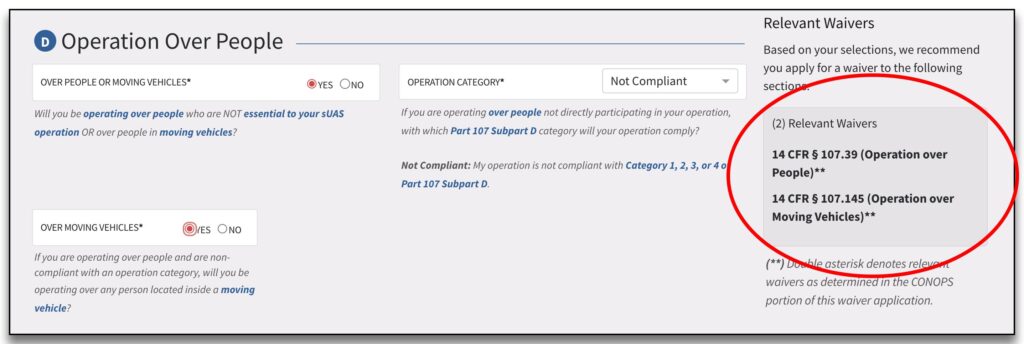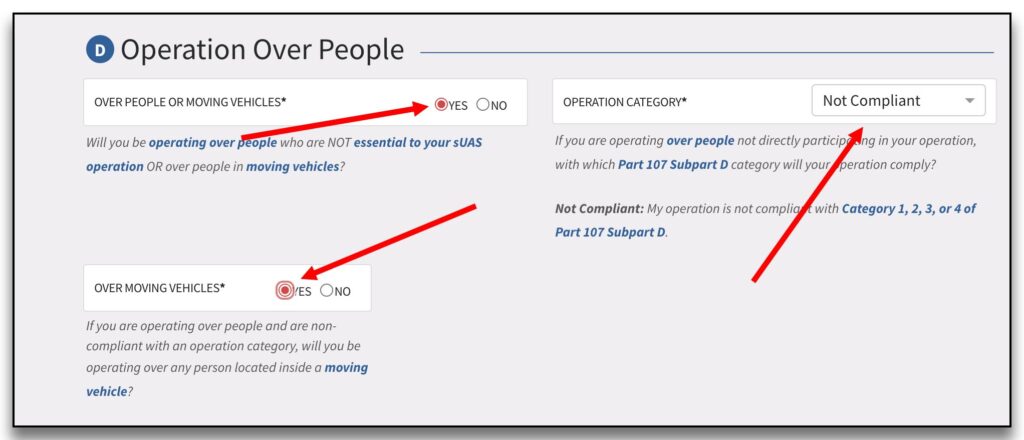Since we first published this article on May 5th, the process has been updated numerous times. When there are new waivers or procedures put in place by the FAA, there are growing pains. And the original article showed plenty of those pains. And it become a pain in and of itself to read.
So here is the (hopefully for the last time) revised article. I’ve been promising this for a while, and I believe we are at a good place to edit this and republish.
_____________________________________________________________________
With the FAA granting of so many new OOP/OOMV waivers (they are now granting more approval than denials for these waivers), we are seeing lots of folk ask about adding drones to their current & approved waiver. The way to do that depends on what you want to add, and what your waiver is approved for.
If you simply want to add a drone that is included in the weight class you have approved (.88 pounds and below, or .88-3.5 pounds), you simply add it to your list of drones you must keep under your current waiver.
If you want to add a larger drone using a PRS, and your current waiver doesn’t include a provision for drones heavier than .88 pounds, then you need to apply for a waiver amendment. Simply start a new waiver like you would normally, but when you get to the operational description boxes, simply say it’s a waiver amendment and include all of the pertinent information there.
You’ll need to mention which PRS you’re using, and mention it is ASTM certified under ASTM F3322-22, and include the total weight of the PRS, prop guards (if used), and 3SM strobe. Make sure you check yes when it asks for “Relevant Existing Waivers” at the bottom of the application, then check the box for the waiver you’re applying for the amendment for.
Submit that and wait. They’ll treat is as a new application and turn around time is about 4-6 weeks still. But it should just be a formality.
DSPA’a ParaZero unboxing video can be seen here.
Pilot Institute’s OOP summary Video here.
_____________________________________________________________________
In May of this year, the FAA released their new approval process for 107.39 (Operations over human beings) and 107.145 (Operations Over Moving Vehicles). It is now almost an automatic process for Remote Pilots to be able to fly over people and people in moving vehicles. Notice I wrote “almost” in that sentence. This is still a need for waiver, and your application must be accurate and complete! Easier for sure, but make sure you’re doing it right.
But first we ask the question, “Why not just change the regulations and make it easier on every Remote Pilot who wants to fly over people?” Well, mainly because changing a regulation literally takes an act of Congress. And since we just were given a new FAA Reauthorization Act, and it’s an election year, odds are Congress won’t have the time (or desire) to deal with Part 107 regulatory change in any timely manner.
So waiver approval policy change is what we get. But it’s a good thing. And it’s well within the ability and scope of the FAA to change approval policies when it comes to such things as waivers. Congress even gave them that permission in 107.200 and then in 107.205 gave them the list of regulations subject to waivers. Amazingly enough, it seems someone in Congress (with assistance from the FAA/DOT I’m sure), had the foresight to know that there would be times when we would need to fly outside the 107 regulations. All we have to do as Remote Pilots is provide “a complete description of the proposed operation and justification that establishes that the operation can safely be conducted”. Then the FAA can grant that waiver if they find “that a proposed small UAS operation can safely be conducted under the terms of that certificate of waiver”.
And it’s the up to the FAA to determine just what is needed to safely conduct an operation that deviates from the regulation. Hence the waiver approval policy change for 107.39.
And remember, you STILL need that waiver to fly anything NOT automatically included in the 107.39 Categories.
So why the policy change if we have the 4 Categories of compliant UAS OOP/OMV operations? Because it become obvious fairly quickly that the criteria for each of those categories was much more difficult to meet than the Congress realized. Manufacturers just didn’t see any ROI on spending the money and time to design and build any OOP Category compliant drones. To date (9/9/24), there is still very few drones with a Category 2 or 3 designation, and they’re all Enterprise drones. Not really usable for the vast majority of Remote Pilots.
The FAA realized they needed to come up with a different approach. So they dug in and came up with a new set of provisions and three new weights classes. And we owe then a huge Thank You!
_____________________________________________________________________
And on 6.16.24, the FAA made it even more clear by releasing the new Waiver Safety Explanation Guidelines (WSEGs) for both §107.39-Operation over Human Beings and §107.145-Operation over Moving Vehicles.
And the WSEGs for both are basically identical. The FAA has realized that OOP and OOMV operations can be done safely, and in the same manner. But the instructions are quite specific. And you must show just cause for the waiver by describing “… the proposed operation in detail”. I’ve been told, “The FAAs preference is still to not fly over people.” Which, if you think about it, makes sense. FAA preferences are to not change rules unless there is data to predicate those changes. And until they have the data, rules and preferences will not change. And flying under your approved waiver will provide those data points to the FAA. So when you get your waiver, make darn sure you follow the provisions and fly accordingly. A waiver does not give you permission to fly willy-nilly over people with wild abandon. Follow the rules, and we can prove to the FAA something all of us know, flying over people (when done right) is about as safe as you can be when it comes to aviation, manned or otherwise.
Back to describing “… the proposed operation in detail” for a minute. The FAA is still hesitant to give waivers “just in case” someone needs them. And even though it’s not in the new WSEGs, its also a very good idea to justify your safety case. Because that wording is in §107.200(b). The proposed operation would need to describe “What sort of operations will you be doing where you need to operate over people. What’s the duration? What’s the purpose? Tell us what your doing and why.” It could be as simple as flying over construction sites, flying in urban environments where it is virtually impossible to not fly over people and people in moving cars, flying First Responder missions, inspection missions, or one of your own choosing. But be specific.
You don’t need to write War & Peace, but do describe your operation in a decent about of detail so they don’t think you’re applying for a waiver “just in case”. To get more info, read provisions in recently granted waivers, and read §107.200 (b).
The FAA sees a lot of waivers stating, “I’ll be safe, and I’ll use a VO, and I’ll equip with this or that, and I’ll fly safely”. That obviously isn’t a very well thought out safety case for a waiver. Yes, explain that you’ll “use a VO, and I’ll equip with this or that”, but don’t stop there.
Read the WSEGs and explain accordingly. These CONOPS (CONcept of OPerations) are what you’ll put in the section for “DESCRIPTION OF YOUR PROPOSED OPERATION” on the waiver application.
And don’t forget that the second WSEG states: “What is the takeoff weight of the sUA, including payload and the required equipage listed below? Express this number to the nearest hundredth pound (i.e., 0.85 lbs., 1.52 lbs.).” You gotta add that to the application.
So keep all of this in mind as you read the rest of this article. As one FAA person told me, “You will need to coach them on how to wade thru the FAADZ (FAA Drone Zone) questions to get to the point where they describe the operation and tell us what the weight is, since we can’t change that inflexible format easily.”
Hopefully this article does just that.
_____________________________________________________________________
So what are the three new weight classes for these waivers? You may have noticed I used the word “classes” and not “categories”. This is deliberate as to not confuse those new waiver weight classes with the current FAA OOP Categories described in Subpart D. We have drones up to and including .88 pounds (400g) in the first class, and drones greater than .88 pounds and up to 3.5 pounds (1587g) in the second class. Drones over 3.5 pounds will be their own weight class and those waivers will be judged individually. We will not go into those in this article. When you fill out the application, make sure you put the full weight of your drone included on the application that includes ALL accessories. Let’s break those down.
Drones .88 pounds or less must contain Remote ID, “shielding for rotating components” (prop guards), and “anti-collision lights”.
We have a list of some <.88 pound drones in our new provision update OOP article.
Drones over .88 pounds up to 3.5 pounds must include RID, a 3SM strobe, plus they need an ASTM (F3322-18 or newer) certified Parachute Recovery System (PRS). For the waivers, there is only one available without an FAA DOC. That is the ParaZero SafeAir Mavic 3. That model PRS is good for ALL Mavic 3 series drones. One major change is that a drone from .88 pounds to 3.5 pounds no longer is required to have a set of Prop Guards. According to the FAA, since that weight class requires a PRS, and the PRS is required to have a Flight Termination System (FTS) that stops the propellers, then the FTS satisfies the requirement that the drones don’t contain “any exposed rotating parts that would lacerate human skin”.
You can certainly add prop guards, and even include them in the total up weight of the drone on your application. But just use a phrase to the affect “prop guards to be included on the .88 to 3.5 weight class if the RPIC determines they are necessary for additional safety mitigation”. That way if you do need them, you’ll have them included in the waiver as total weight.
When filling out the waiver application for those under 3.5 pounds, you’ll need to log into your Drone Zone account. The steps remain the same as other waivers.
Steps:
- Click “CREATE PART 107 WAIVER/AUTHORIZATION” link.

- Choose “OPERATIONAL WAIVER”, click “START APPLICATION”.

- Answer all of the questions in the “CONOPS” section of the application. One hint, choose “Stationary Vehicle” when it asks about control station. That’s not particularly clear.

- When you get to section D “Operations Over People” click “Yes” for “OVER PEOPLE OR MOVING VEHICLES”, choose “Not Compliant” for category, then click “Yes” for “OVER MOVING VEHICLE”.

- If you’ve done this right, then you’ll notice that the relevant waiver section on the very right of the page now shows you need a 107.39 Waiver, and well as a 107.145 Waiver. If you have different ones listed, double check your answers. You’ve done something wrong.

Then you’ll fill out the CONOPS on the next page for 107.39 & 107.145. Don’t try and add more waiverable regulations to this application. Just stick with those two.
Click “Next” and review your answers, then click “Next” again.
Here is where you’ll name your waiver. Just choose something simple. This is only for your reference, the FAA isn’t going to care about this. I suggest something simply like “107.39 waiver app”. This is so you can track it easily, or modify it if you need to before you hit “Submit” in the final step. So name it and click “CONTINUE”. Or just name it “Bob”.
Next page give you the name of the Responsible Party, and pilot if you want to add that. Add yourself here as well. Just click the box under “PILOT”. Click “NEXT” and we’re into the meat and potatoes of the application.
Fill in the 107.145 “WAIVER SAFETY EXPLANATION” boxes. State that drones you’ll fly will all be .88 pounds or less, include RID, prop guards, and anti-collision lights. If you’re applying for a drone from .88 pounds to 3.5 pounds, include the PRS model, and attach the ASTM certification paperwork at the next step if you have it. If you don’t, mention that you’ll be using the ParaZero ASTM Certified SafeAir Mavic 3 PRS. Include a link if you want. It is NOT required that you already own the ParaZero SafeAir system before you apply for the waiver. Include some of the provision you’ll find in approved 107.39 waivers. You can find them at the FAA’s accepted waiver page. Go to that page and search 107.39 Waivers. And include a brief safety mitigation plan based on the provision in the approved 107.39 waivers. Keep it from being too long, but 150 words or so is good. You’ll add things like requiring a VO, preflight safety meeting, coordination with event staff, alternate LZs, etc. Read the approved waivers for more ideas. I can’t stress that enough. Choose a start date, 60 days is plenty, and they’ll adjust it accordingly. Choose an end date, and make it as long as you can. Fill in the location box by mentioning where you want to fly. I suggest all of Class G, and controlled airspace up to UASFM limits. 400’ is the max altitude with LAANC permission, and check any existing waivers or authorizations you want to include in this application. I suggest just leaving this blank for now. You can add this waiver to future applications.
As of today (9/9/24), ATO is NOT allowing waivers to be used with the LAANC system. But include that language anyway. When I spoke with the FAA at the 2024 Commercial UAV Expo, they mentioned they are in the process of making it allowable to use LAANC with the waivers. I’ll update this when it becomes a reality.
Click “NEXT” and add any compliant drones from your inventory here, then “NEXT” again, and this takes you to the final page. Review your application and add any attachments here, such as your ASTM certification if you have it. Double check everything again, and click “SUBMIT”.
It’s that simple these days. If you get a Request of Information (RFI), that means you didn’t include something, or they’d like a bit more info from you. The most common we see is asking what missions you’ll be using. Make sure you do that in your original application. If you do get an RFI, simply answer those questions, and submit that addition information within 30 days.
Once you get your waiver, simply follow the included provision when you fly, and you’re good to go. Your final waiver will contain a total of around 22 or so special and common provisions. But none of them are overly burdensome, unlike OOP waivers of the past. Compliance with each of these is incredibly simple.
Remember, flying over people adds additional risks to your operation. Obtaining a 107.39 waiver does not magically make ops over people safe. You still need to approach each and ever OOP mission with safety as your primary decision factor in the “go, no go” process. Flying under your 107.39 waiver makes OOP missions much safer, but not 100% safe. Remember that.
_____________________________________________________________
One more word of advice. Flying with prop guards on your drone definitely affects the flight characteristics. Especially if any wind at all is present. The first time I flew my Mini 3 Pro under my waiver, it was slightly breezy. At one point, when I was transitioning into a hover, the drone “porpoised” briefly. It was only for about 2 seconds or so, but since I was over a Division 1 football game at the time (legally, of course), it seems like it did it forever. Definitely a sphincter tightening moment. I had tested the drone under some flight conditions to see how it would handle, but not in any wind. Learn from my mistake, don’t make one of your own. Once I realized that was going to be normal behavior, I relaxed a little bit and finished the project. However, I did keep an eye on the wind for the rest of the game, as I should anyway. If the wind had increased at any point during that game, I would have shut the operation down. Personally, if a wind is over 4-5 MPH, I’m not flying my Minis under my waiver. But that decision is up to each and every one of you.
_____________________________________________________________
Drone Service Providers Alliance provides “Professional advocacy for Drone Service Providers throughout the United States”. Our mission statement is “A United Voice for Positive Change”. We are a dues supported 501(c)(6) organization. Dues are used to cover travel and operating expenses. No salaries are taken by Kenji and Vic for the work they do on behalf of the U.S. UAS industry. We fully believe a rising tide lifts all boats. And since we also fly drones for a living, it will benefit us as well.
If you believe in what we do, please consider joining us, we appreciate any and all support: https://dspalliance.org/join-us/
Also, have you added to your drone fleet? Do you know the ins and outs of your new drone? Check out Pilot Institute’s Deep Dive Videos. Greg and crew do an great job helping you understand your drone better. And each and every Deep Dive Video is free.
Also, if you don’t have your 107 yet, or are looking to add UAS Verticals, check out the Pilot Institute site for additional classes. They have business classes, a VO class (pay for your VOs to take it), mapping, photography, and more. Check out their offerings here!
Need a new drone? Need to rent one for a specific job? Need some repair work done? Blue Skies Drones is your answer to all of these questions.
And if you’re worried about the current anti-China fervor in D.C. and many states, please seriously consider joining Drone Advocacy Alliance. Let’s work together to stop Congress from picking industry winners and losers.
And as always FLY SAFE!






Thank you for sharing this insightful article. The detailed explanations and practical tips you provided are much appreciated.